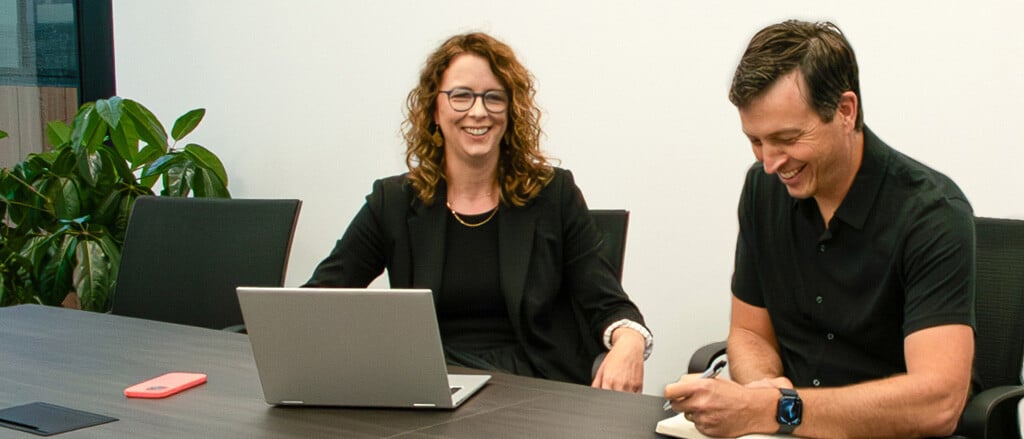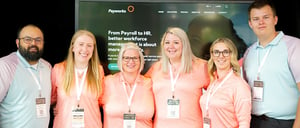
Leadership lessons: The best advice our CTO received (and still shares to this day)
Meet Maureen Kinnear! We’re thrilled to have recently welcomed her to Payworks as Chief Technology Officer, where she oversees Payworks’ talented Development, Product Management and Information Technology teams.
Maureen brings over two decades of global leadership in technology teams to her role, so naturally we wanted to sit down with her to gather any insights she was willing to share – on her own evolution as a leader, the folks who made a difference along the way, and the most important qualities that any leader can bring to their team.
For your inspiration, and in her own words: Maureen’s leadership story.

Photo: Maureen Kinnear, Payworks’ Chief Technology Officer.
At what stage in your career did you start to think that you eventually wanted to lead people?
I didn’t start out with the goal of becoming a leader. In the early days, I was really enjoying building my technical skills. I loved the analysis, the challenge, and the urgency of having to learn on the fly when things broke!
I also loved working with a team – I had access to really smart and experienced people, some of whom had been in their roles for over 20 years. They saw potential in me and offered me my first leadership role – which I was initially hesitant to accept until a dear friend talked some sense into me, as all good friends do < laughs >.
What surprised me is that all the things I liked about being in a technical contributor role were just as present in a leadership role – the complexities, the challenges – but now I had the opportunity to provide guidance to the team based upon my own experience. I could help them keep calm because, based on what I’d encountered and my learnings over the years, I had the confidence that we’d all make it through to the other side together.
As a new leader, I was concerned that I’d have less of an opportunity for continuous learning – one of the most rewarding parts of any role for me. I couldn’t have been more wrong. Technology is constantly changing and evolving, requiring all IT professionals to keep knowledge and skills up to date to stay relevant. In addition to teaching me how to help organizations continuously innovate, my own leaders were excellent at recognizing new opportunities for me and presenting them to me every time I started to get even the slightest bit comfortable
< laughs >.
In general, what I learned in the process of becoming a leader myself is that your coaches and mentors have developed wisdom through their experiences, and if they think something is a good fit for you, at the very least it’s worth taking it under consideration. The leadership opportunities they presented which I was least excited about in the moment ended up being the ones I found most valuable and rewarding.
Did you have any mentors who showed by their example how to be a good leader?
I’ve been lucky enough to have several! One was a senior leader based in Australia who was always direct and honest in his approach. I counted on him for the blunt and timely truth. He helped me navigate everything from office politics to finding new technical leadership opportunities. One of the best pieces of advice he ever gave me was, “Maureen, if you see a lack of leadership in the room, just step up and lead. Go for it.” I pass this advice onto others to this day.
I also had two female executive allies in Houston who championed my career growth. They were very strong advocates for my potential and capability, and helped open doors for me with global leaders who otherwise wouldn’t have even known who I was. With the opportunities that came from their belief in me, I was thrown into the fire, taking on very challenging roles. I’m so thankful for their support. Because of the corporate exposure they afforded me, my toolkit of experience and skills has gotten a whole lot bigger. I’ve tried to identify opportunities like that for others ever since then.
I won’t forget the mentors who made room for me at the table when I spent a portion of my career working in the Production Department in Oil and Gas. As an IT professional and not an engineer by trade, my perspective didn’t confer with others simply because my training and experience were different. There are four senior execs that took a ton of time out of their own very busy schedules to teach me about the Production business. They were also the ones who showed me that my bringing a different perspective wasn’t a cause for imposter syndrome; it was adding significant value. I remember one mentor encouraging me never to change, that the company needed more voices like mine, testing the status quo. I was needed at that table. That’s a message I’ve tried to impart to my own teams as much as possible, and one that’s guided my hiring as well.
.jpg?width=550&height=310&name=09132024_UW_PancakeBreakfast_edit%20(17).jpg)
Photo: Maureen and a few members of the crew kicking off Payworks’ 2024 United Way Winnipeg Workplace Campaign with some early morning pancakes.
How has your experience as a woman in technology impacted your journey as a leader, if at all?
At the beginning of my career in technical roles, I was often the only woman at the table. And because I was “the only one of my kind” there, I always put in extra time to prepare so that I could show up competent and confident. This eventually positioned me as the go-to for knowing the detail and providing unique perspective that the team ended up relying upon. They knew they could trust me to stick to the facts, ask valuable questions, and to never throw anyone under the bus. They understood that my approach was always in pursuit of the best solution.
But that wouldn’t have been nearly as easy without the mentors I described earlier, who were telling me “Speak up. Raise your voice. Your perspective is needed at the table.” It took time to build that confidence. But now, I don’t even think about it anymore. What I think about now is ensuring that those at the table are comfortable sharing their voice, and if they aren’t, I try to draw it out.
What does a “positive company culture” mean to you, and how can you foster that as a leader?
To me, a positive company culture means a workplace that’s psychologically safe – where people feel valued and free to be their whole selves every day – and offers work that’s rewarding, as well as support to achieve individual and collective goals. As a leader, it’s my job to positively reinforce each of those elements every day through both my words and my actions.
The litmus test for me is consistency over intensity. By that I mean: what are the small things that happen on a daily basis, as opposed to major celebrations or big events? While the latter are wonderful if the culture’s already strong, it’s really the day to day that matters and gives you the truest read on how being part of your organization actually feels for your employees.
In your mind, what’s the ideal balance between “doing” and “supporting” when it comes to leading your people?
Figuring out “how to lead” versus “how to do” is definitely an ongoing process for any leader.
Overall, I know that I’m more effective as a leader if I let my people handle the technical details. Gosh, I love rolling up my sleeves but I have to resist! < laughs > I’m certainly there to step in if they could use an extra hand in managing an unexpected curveball, and think it’s important to maintain flexibility in how I deliver support. In general, I’m there to protect and support the team so that they can focus on solving the problem.
Ultimately for me, it’s been about learning how to ask more questions – including asking people what they’re looking for when they come to me. Is it simply a listening ear, or is it a partner in finding a solution to a problem? I also learned very quickly how to delegate rather than rushing in to fix things myself. As roles broaden in scope and span of control, doing becomes unsustainable and deprives the team of their own opportunities to learn, grow, and feel pride in what they’ve accomplished.

Photo: “What I think about now is ensuring that those at the table are comfortable sharing their voice, and if they aren’t, I try to draw it out,” says Maureen.
Your field evolves quickly. How do you stay on top of changing trends and best practices, and how do you ensure your team is along for the ride?
Continuous learning is paramount in IT. I leverage several sources to keep up with trends and best practices, such as research tools, external forums, boards, vendors, trade events and more. It’s up to leaders – especially within the technology sector – to stay connected with peers outside the organization and also to explore quantitative data, as both approaches differently illuminate the stories of where our field is headed.
I also look to members of my own team at all levels, whether they’re fresh out of school with training in technology I’ve never used, or have been part of the industry for years and are exploring new options through the lens of their experience.
How can people leaders most effectively manage growth?
You can’t grow effectively if you don’t deliver on the things that got you to the place that enabled growth in the first place. Whatever’s brought you your success can’t be left by the wayside; the foundation needs to stay strong. So don’t get so blinded by opportunity that you forget who you are or where you came from!
That reflection on the past will also help motivate your team to push through any fear or stress associated with growth. It’s important that teams understand it was their skills, dedication and ideas that brought this growth to fruition so that they feel part of what’s coming next and confident that they can handle it – just as they always have.
Top five most important attributes of a good people leader – go!
1. Listen – and not just with your ears.
Read body language; stay aware of the passing comments in the hallway and the tone of people’s voices. Keep all your senses open so that you can instinctually and proactively make a positive impact by serving teams where they need it most… or might not even know they need it.
2. Understand that you’re there to help your team members grow.
Work with them to figure out what their aspirations are and then collaborate and align on helping them fill gaps and explore new opportunities so that they can achieve them. I’m going to steal a phrase from my colleague Jenn Johnston (Payworks’ Vice President of Human Resources): think of team growth opportunities as “ready enough” – meaning making room for the opportunity if the individual or team is not quite 100% ready, but ready enough to stretch into it. I love when teams come to me telling me they feel a bit “sick” about a new challenge – my response is, “Get ready, you’re going to grow!”
3. Recognize the gift that is the chance to learn from your team.
Learning remains a two-way street at every stage of your career. We’re all growing together.
4. Celebrate both successes and the learnings that occur through failure.
The science of what we do changes quickly, and sometimes your hypothesis will be correct… but sometimes it won’t. Both are equally important in guiding the path forward to solve problems the right way.
5. Keep your door open (literally and metaphorically).
It’s so important for individuals to feel safe to speak up, to disagree, to bring their own perspective. I’ve yet to be in a situation where at least considering an opinion that breaks with the popular vote hasn’t made our change plan or our product better in the long run.
Ready to spend more time on the big picture? With Payworks’ unified suite of workforce management solutions, you can reduce your stress and paperwork, and focus on your people instead. Learn more: https://www.payworks.ca/solutions/overview.
These articles are produced by Payworks as an information service. They are not intended to substitute professional legal, regulatory, tax, or financial advice. Readers must rely on their own advisors, as applicable, for such advice.














